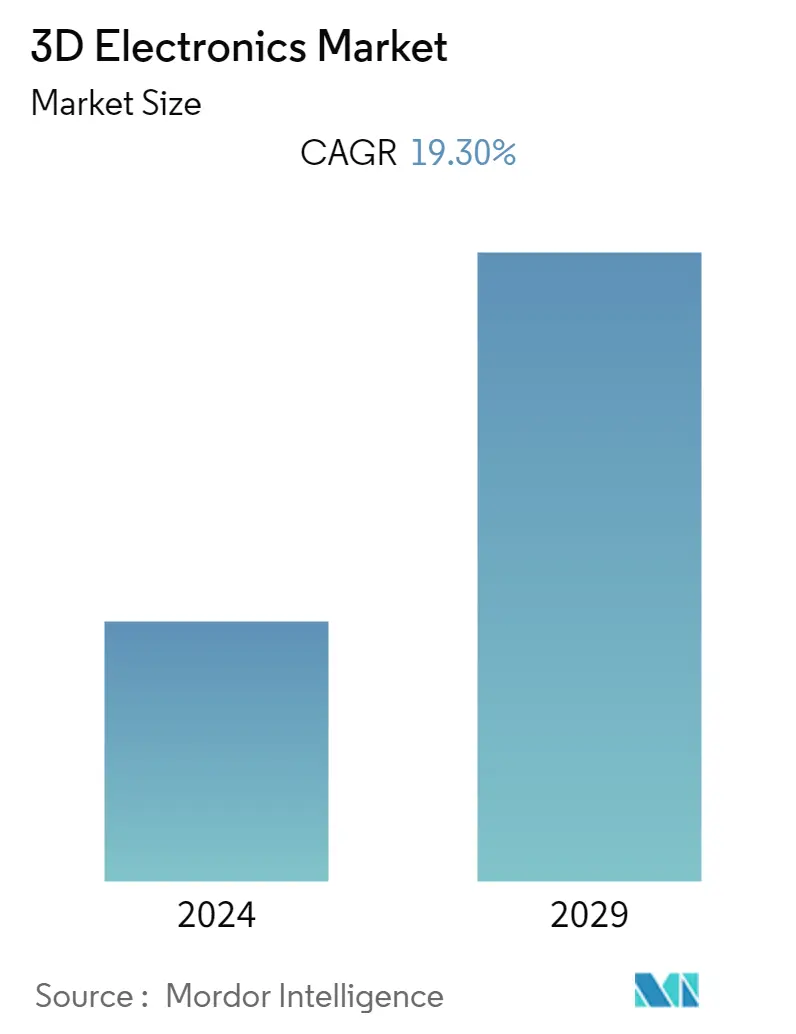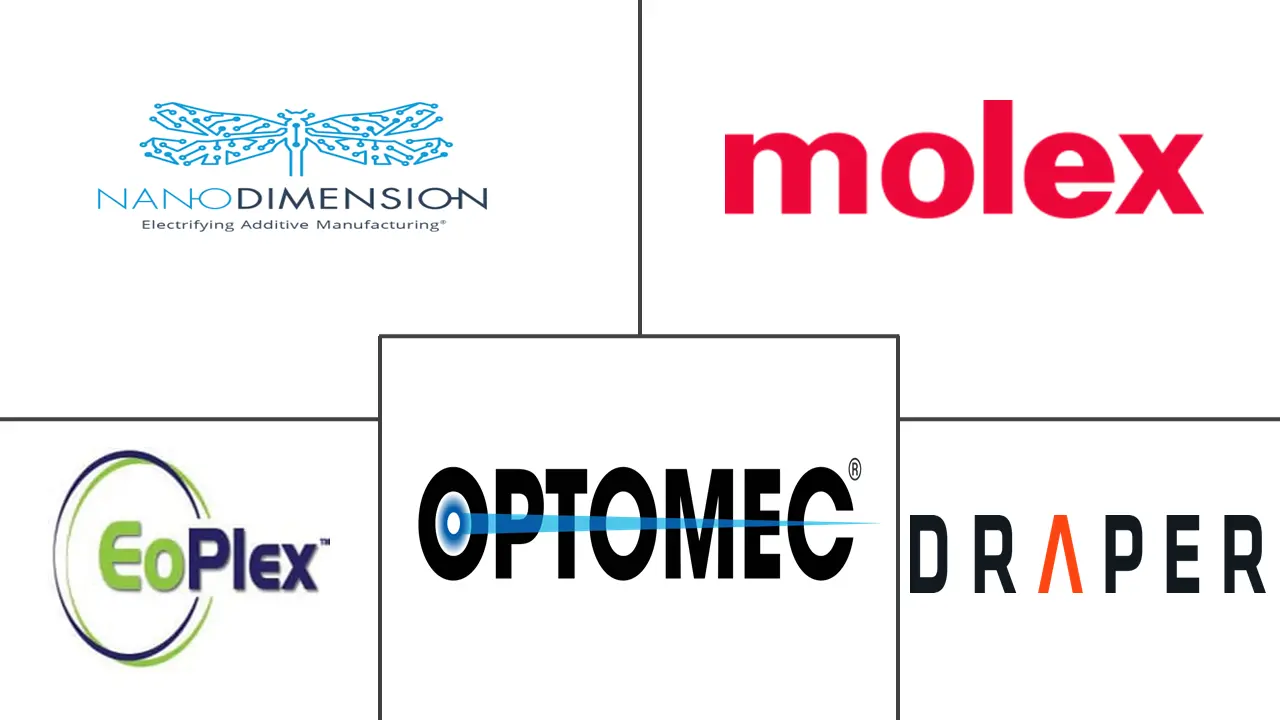Market Size of 3D Electronics Industry

| Study Period | 2019 - 2029 |
| Base Year For Estimation | 2023 |
| CAGR | 19.30 % |
| Fastest Growing Market | Asia-Pacific |
| Largest Market | North America |
| Market Concentration | Medium |
Major Players
*Disclaimer: Major Players sorted in no particular order |
3D Electronics Market Analysis
The 3D electronics market is expected to register a CAGR of 19.3% over the forecast period. Increasing innovation in 3D electronics has led manufacturing of Wirewraps and point-to-point printed circuit boards (PCBs). 3D electronics, which provide complete circuits to be integrated within an object, are on the rise as they continue to undergo extensive innovation, metallization methods, and manufacturing methodologies, thus boosting market growth.
- The demand for 3D electronics is increasing because 3D additive electronics allow complete circuits to be integrated within an object, resulting in numerous advantages, such as simplified manufacturing and novel form factors. Adding electronic functionality to a 3D object no longer necessitates incorporating a rigid, planar PCB into the object and wiring up the relevant switches, sensors, power sources, and other external components.
- Three-dimensional (3D) printing of electronics has attracted significant interest due to the unique advantages it offers that are not achievable by traditional electronic manufacturing processes and systems. For instance, on-demand fabrication of highly-customizable electronics, novel device designs in three dimensions, and direct fabrication on a wide variety of substrates and conformal surfaces.
- The demand for the 3D electronics market is likely to grow with more significant rivalry owing to the accessibility of the fresh entrants and higher performance due to the fast adoption of the novel produced tech in a variety of sectors, including military, healthcare, electrified system, communications, car industry, aerospace, energy utilities, and others.
- The limitation of the associate material coupled with the complexity related to the 3D electronics is expected to hinder the market growth over the study period. Further, high yields are particularly essential because completely enclosed circuits cannot be repaired; thus, one damaged connection renders the entire part superfluous.
- The electronics industry has suffered due to the global spread of the COVID-19 pandemic. The leading hypermarkets, supermarkets, and showrooms have been closed, affecting sales of various electronics products. Because of the implications of the measures during the lockdown, businesses worldwide have adopted remote working as a tool to continue their business processes. However, the sales of various consumer electronic items such as laptops and PCs, among others, witnessed a significant rise in demand.
3D Electronics Industry Segmentation
The 3D electronics market is segmented based on Manufacturing Techniques (Electronics on a Surface, In-Mold Electronics (IME), Fully 3D Printed Electronics), Technology Type (Aerosol Jetting, Laser Induced Forward Transfer (LIFT)), By End-use Vertical (Automotive, Consumer Electronics, Medical, Telecommunication), and by Geography.
| By Manufacturing Techniques | |
| Electronics on a Surface | |
| In-Mold Electronics (IME) | |
| Fully 3D Printed Electronics |
| By Technology Type | |
| Aerosol jetting | |
| Laser Induced Forward Transfer (LIFT) | |
| Others |
| By End-use Vertical | |
| Automotive | |
| Consumer Electronics | |
| Medical | |
| Telecommunication | |
| Others |
| By Geography | |
| North America | |
| Europe | |
| Asia-Pacific | |
| Latin America | |
| Middle-East and Africa |
3D Electronics Market Size Summary
The 3D electronics market is experiencing significant growth, driven by advancements in additive manufacturing technologies that allow for the integration of complete circuits within objects. This innovation eliminates the need for traditional rigid, planar printed circuit boards, offering benefits such as simplified manufacturing and the ability to create novel form factors. The market is gaining traction across various sectors, including military, healthcare, communications, and automotive, due to the increasing demand for smaller, more efficient devices with advanced functionalities. Despite challenges such as material limitations and the complexity of 3D electronics, the market is poised for expansion as manufacturers seek to enhance efficiency and reduce costs through in-house prototyping and customization.
North America is expected to maintain its dominant position in the global 3D electronics market, with the United States and Canada leading the charge due to their robust manufacturing industries and early adoption of 3D printing technologies. The region's growth is fueled by the increasing use of 3D printed electronics in sectors like aerospace, defense, and automotive, where these technologies offer advantages such as reduced production costs and improved design capabilities. The market is moderately consolidated, with key players like Nano Dimension Ltd, Molex LLC, and Optomec Inc. focusing on technological advancements and strategic collaborations to meet the rising demand. As the market continues to evolve, it is set to revolutionize electronic development and prototyping, offering new opportunities for innovation and efficiency.
3D Electronics Market Size - Table of Contents
-
1. MARKET INSIGHTS
-
1.1 Market Overview
-
1.2 Industry Value Chain Analysis
-
1.3 Industry Attractiveness - Porter's Five Forces Analysis
-
1.3.1 Bargaining Power of Suppliers
-
1.3.2 Bargaining Power of Consumers
-
1.3.3 Threat of New Entrants
-
1.3.4 Intensity of Competitive Rivalry
-
1.3.5 Threat of Substitutes
-
-
1.4 COVID-19 Impact on the Market
-
-
2. MARKET SEGMENTATION
-
2.1 By Manufacturing Techniques
-
2.1.1 Electronics on a Surface
-
2.1.2 In-Mold Electronics (IME)
-
2.1.3 Fully 3D Printed Electronics
-
-
2.2 By Technology Type
-
2.2.1 Aerosol jetting
-
2.2.2 Laser Induced Forward Transfer (LIFT)
-
2.2.3 Others
-
-
2.3 By End-use Vertical
-
2.3.1 Automotive
-
2.3.2 Consumer Electronics
-
2.3.3 Medical
-
2.3.4 Telecommunication
-
2.3.5 Others
-
-
2.4 By Geography
-
2.4.1 North America
-
2.4.2 Europe
-
2.4.3 Asia-Pacific
-
2.4.4 Latin America
-
2.4.5 Middle-East and Africa
-
-
3D Electronics Market Size FAQs
What is the current 3D Electronics Market size?
The 3D Electronics Market is projected to register a CAGR of 19.30% during the forecast period (2024-2029)
Who are the key players in 3D Electronics Market?
Nano Dimension Ltd, Molex LLC, EoPlex, Inc, Optomec Inc. and Draper Laboratory, Inc. are the major companies operating in the 3D Electronics Market.

